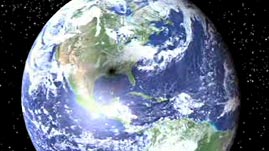Teachers' Domain - Digital Media for the Classroom and Professional Development
User: Preview

Source: NASA/JPL-Caltech
Every now and then, the Sun, Earth, and Moon align so that, when viewed from the Earth, the Moon eclipses the Sun's light. Solar eclipses are fairly common -- the Moon will block out some portion of the Sun at least twice a year. However, it is still a special event to be able to witness a total solar eclipse. In this video segment adapted from NASA, learn how solar eclipses happen and why they are so difficult to witness.
The Moon cycles through its phases during its 29.5-day orbit around Earth. While the Sun always illuminates half of the Moon, the apparent shape of the Moon as seen from Earth depends on Earth's relative position. For example, at full moon, the Moon appears as a full disk because Earth is between the Moon and the Sun and the illuminated side faces Earth. But at new moon, when the Moon is between the Sun and Earth, the Moon seems to be gone because the lit side faces away from Earth. A solar eclipse is only possible during the new moon phase, when the Moon's shadow can be cast on Earth. During the full moon, Earth's shadow can be cast on the Moon, resulting in a lunar eclipse.
There are several different types of eclipses, corresponding to how the Sun, Earth, and Moon align. The shadows of the Moon and Earth each have two parts. The umbra is the central part of the shadow where sunlight is completely blocked; the penumbra is the outer area where sunlight is only partially blocked. Depending on which part of the Moon's shadow is cast on Earth, a solar eclipse can be partial, annular, or total. Similarly, there are three types of lunar eclipses -- penumbral, partial, and total -- depending on which section of Earth's shadow the Moon passes through.
Eclipses do not happen at the new and full moon every month because, for most of its orbit, the Moon is above or below the ecliptic plane -- the plane of Earth's orbit around the Sun. Only when the Moon's orbit crosses through the ecliptic plane, can the Sun, Moon, and Earth align to produce an eclipse. This occurs at least twice a year, at varying times, for a period of a few weeks. During such seasons, there will always be a solar eclipse and a lunar eclipse. Occasionally, the three bodies also align at other times of the year, producing up to seven eclipses in one year.
Though eclipses are common, total eclipses are quite rare. It is a special treat to witness a total solar eclipse, which happens only about once every 1.5 years, lasts only a few minutes, and is only visible along a narrow path. Lunar eclipses, on the other hand, can last as long as a couple of hours, are often easily observed with the naked eye, and are visible from the entire nighttime side of Earth.
 Loading Standards
Loading Standards Teachers' Domain is proud to be a Pathways portal to the National Science Digital Library.
Teachers' Domain is proud to be a Pathways portal to the National Science Digital Library.
